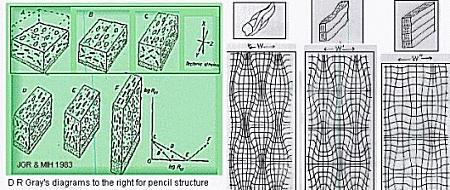 |
| CLEAVAGE, SLATY ORIGIN
Most tectonically undeformed shales and marls possess a fabric as a result of sedimentation and diagenetic processes. This fabric is parallel to the bedding planes and develops first from the stable hydrodynamic orientation of large platy minerals (e.g. muscovite) parallel to bedding and second (and probably more important) from the effect of diagenetic compaction on the clay minerals present in the initial mud by overburden pressure and expulsion of pore water. This is a primary planar fabric known as bedding plane fissility. The earliest stages of tectonic deformation lead to a contraction sub-parallel to the bedding surface. This deformation is usually accompanied by considerable volume loss as a result of mechanical closure of pore spaces left after diagenetic compaction and the expulsion of pore water contained in the initial shale. The effects of deformation are analogous to the effect of compressing a sponge: the elongation in the tectonic X-direction taking place normal to the contraction direction Z is small compared with the amount of shortening taking place. As a result of volume loss, this elongation in no way compensates for the degree of the contraction. The initial fissility of the shale theldore becomes slightly modified: the bedding plane fabric becomes rather less well marked as a result of rotation of platy elements around the tectonic Y axis, and a very weak linear orientation of any acicular minerals begins to form as they rotate towards the Y-tectonic direction. The rock now has a weak bedding plane fabric and a very weak (but probably undetectable) linear fabric. With increasing tectonic strain, perhaps accompanied by further volume loss by pore reduction, the strain ellipsoid takes on a more prolate form, eventually producin,g a uniaxial prolate or cigar-shaped ellipsoid. The longest axis of this ellipsoid is parallel to the tectonic Y-direction. At this stage the tectonic shortening is slight, but sufficient to compensate in the XZ principal plane for the initial diagenetic compaction. Ellipsoids with shapes of 2: 1: 1 are typical, and tectonic shortenings ranging from 10 to 25% are general. At this stage the mineral rotations that have taken place are usually sufficient to produce a fabric strong enough to give a mechanical weakness to the rock; The rock tends to break into elongated fragments giving a characteristic pencil structure. This structure has sometimes been called pencil cleavage, but this terminology is lnot recommended because a genuine pencil structure has no truely planar cleavage elements. Pencil structure is best formed in perfectly homogeneous argillaceous rock. The cross sectional shapes of the pencils are usually bounded irregular polygonal or curvelinear walls. If folds are present in the rock, the pencil lineation is usually sub-parallel to the fold axes. The next stage in increasing tectonic strain leads to a weakening of the prolate nature of the strain ellipsoid and the progressive movement of the ellipsoid into the apparent flattening field of the logarithmic strain plot. These changes are caused by progressive shortening in the tectonic Z-direction and elongation in the Xdirection. The total ellipsoid XY plane (which coincided with the bedding plane between stages A and C) now crosscuts the bedding plane to coincide with the tectonic X. At this stage in the deformation sequence the tectonic effect is sufficiently strong to form the dominant with rock fabric, a planar cleavage cross-cutting the bedding planes, platy and acicular minerals are oriented in cleavage plane; However they are generally without any lithology to produce a crudely developed intersection pencil structure parallel to the hinge lines of nearby folds. In its early stages of formation this intersection pencil structure may be parallel to the true pencil structure, but genetically the two are unrelated. In fact, one sometimes observes that the true pencil structure is slightly oblique to the intersection pencil structure. At this stage of cleavage formation the fabric is rarely sufficiently strongly formed for the rock to be exploited to form good workable slates. |
SLATY CLEAVAGE AND MARCH MODEL
March proposed that foliations formed by the micas acting as passive strain markers, i.e. that they deformed along with the matrix. This implies that the micas changed shape during deformation.
Slaty cleavages are primary cleavages which are now believed to form by a combination of processes i.e. bend of micas, rigid body rotation, recrystallisation of existing micas and growth of new micas.